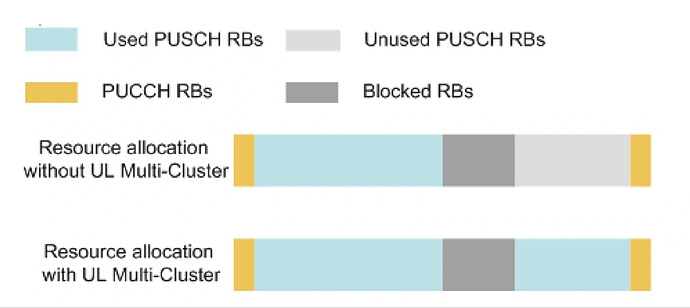The uplink PRBs allocated by the eNodeB to a single UE must be contiguous, uplink PRB resources cannot be fully utilized because there remain multiple non-contiguous PRB segments that cannot be allocated to the same UE in the event of multi-UE scheduling or RB blocking.
-
UL Multi-Cluster (Huawei) or Uplink Resource allocation type 1 (3GPP) was introduced to 3GPP TS 36.213 in Release 10, when using this feature the eNB can allocate a maximum of two non-contiguous PRB clusters to a single UE.
-
In the specifications there are two types of resource allocation:
- Uplink Resource allocation type 0
- Uplink Resource allocation type 1
-
In Uplink Resource allocation type 0: The resource allocation information for uplink resource allocation type 0 indicates to a scheduled UE a set of contiguously allocated virtual resource block indices denoted by VRB.
-
In Uplink Resource allocation type 1: The resource allocation information for uplink resource allocation type 1 indicates to a scheduled UE two sets of resource blocks with each set including one or more consecutive resource block groups of size P.
- P is the RBG (Resource Block Group) size, and can be 1, 2, 3, 4.
-
With this function, the uplink scheduler can allocate a maximum of two non-contiguous PRB clusters to a single UE.
-
Each cluster consists of an integer multiple of RBGs that are contiguous.
-
The figure illustrates the principles for UL Multi-Cluster or Uplink Resource allocation type 1.
-
To activate the feature in Huawei: enabled the UlMultiClusterSwitch option of the CellAlgoSwitch.UlSchExtSwitch
-
Practically this feature increased Uplink data volume by 6% and PRB Utilization by 3% after applying it across a cluster of 4G sites.
-
3GPP TS 36.213 Release 10
LinkedIn: ![]()
